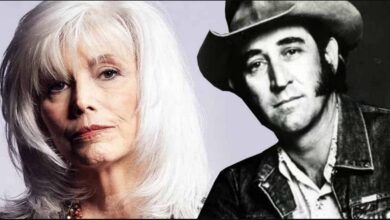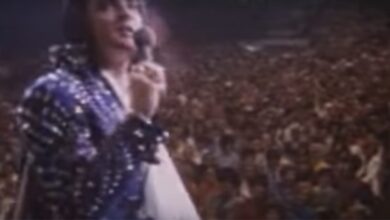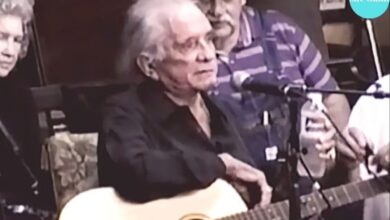This Popular Dance from the 1950s, Do You Remember It Now
In February 1958, a dance craze took hold of American high school gyms and sock hops, capturing the vibrant spirit of the era and embodying the carefree energy of rock ‘n’ roll’s early days. This dance was “The Stroll,” a line dance that quickly became associated with youthful fun and spontaneity. Originating in African American communities, it swept the nation, gaining widespread popularity through television, particularly on Dick Clark’s influential “American Bandstand.” This show showcased the latest musical hits and dance trends, allowing teenagers across the country to see “The Stroll” in action and adopt it eagerly at local gatherings.
“The Stroll” emerged as more than just a dance; it became a cultural phenomenon reflecting the social dynamics of 1950s America. Featuring two lines of participants facing each other, the dance created an aisle down the middle, allowing couples to take turns strutting down this path in rhythm with accompanying music. This format allowed for both group participation and individual expression, making it resonate with youth who were beginning to carve out their identities in a rapidly evolving society. Young dancers could showcase personal flair with variations in their movements, making “The Stroll” not just a coordinated series of steps, but a canvas for personal creativity and interaction.
The song that accompanied this dance, “The Stroll,” was performed by The Diamonds, a Canadian vocal group that became synonymous with smooth harmonies and catchy doo-wop melodies. The Diamonds’ version of “The Stroll” was vital in popularizing the dance, as it encapsulated the energetic and playful mood of the time. Lead singer Dave Somerville, with his rich baritone voice, became the embodiment of youthful exuberance, guiding dancers through the infectious rhythm of the song. The group’s signature sound blended pop sensibilities with the emotive depth of doo-wop, making them a favorite among the teen audience that was increasingly yearning for their own expressions of identity and connection.
As “The Stroll” gained popularity, it became a staple at various social events, from birthday parties to school dances. Its inherent accessibility appealed to a wide range of participants, bridging not just the generational divide but also crossing racial and social lines during a time dominated by segregation. Families and teenagers from diverse backgrounds would come together to enjoy the music and the dance, illustrating how a simple yet captivating activity could promote camaraderie and shared experience. By participating in this joyous dance, individuals could momentarily transcend the societal barriers of the day.
The simplicity of “The Stroll” contributed significantly to its widespread appeal. No prior dance training was required, as the movements were straightforward and easily learned. Teenagers dressed in their best outfits—often slicked-back hair and coiled dresses—would eagerly hit the dance floor, exuding confidence that mirrored the hopeful optimism of post-war America. The vibrancy of the dance breathed a sense of liberation into a generation that was keen to celebrate their newfound freedoms.
In many ways, “The Stroll” personified a generation’s yearning for self-expression and enjoyment in an era marked by sweeping social changes. Its constant presence on television and popular music solidified “The Stroll” as a crucial part of American pop culture. It transformed social gatherings from mere events into memorable experiences charged with the joyful spirit of youth. The dance encapsulated the feelings of joy, rebellion, and cultural pride that pervaded many aspects of life during the 1950s, marking it as a powerful symbol of resistance against conformity.
The legacy of “The Stroll” endures beyond its initial popularity, serving as a cherished memory for those who participated in the dance or listened to The Diamonds’ infectious tune. The dance has been reimagined in various forms over the years, often resurfacing at nostalgic gatherings, showcasing its timelessness. Older generations often reminisce about their experiences and share them with younger ones, creating an intergenerational connection that underscores the importance of music and dance in shaping social dynamics.
Additionally, as time progressed, the collective memory of “The Stroll” and its accompanying song took on new meanings, evolving into a symbol of the era’s challenge of conformity. The dance became emblematic of the broader cultural shifts happening in the United States, as younger people sought to establish their identities in a world that was rapidly changing. The popularity of “The Stroll” and similar dances paved the way for future dance styles and music genres, contributing to the rich tapestry of American cultural history.
The Diamonds themselves continued to weave their own narrative in the music industry. Starting in the early 1950s, the group came together with the intent to create harmonious and catchy pop music that reflected the optimism of the times. The blend of their voices and their doo-wop roots resonated with a wide audience. Over the years, they released numerous hits, embracing the ever-evolving landscape of popular music while retaining their signature sound. In that way, they remained relevant and influential, transcending the initial wave of rock ‘n’ roll and continuing to inspire new artists.
In conclusion, “The Stroll” is much more than a dance; it is a celebration of youth, freedom, and cultural connection. Its emergence in the late 1950s encapsulates a specific moment in American history marked by a longing for self-expression amidst the prevailing norms. Accompanied by the harmonious sounds of The Diamonds, “The Stroll” solidified its place as a cultural phenomenon, leaving a lasting legacy that continues to resonate today. Through memories shared and dances revisited, this iconic movement remains a vivid reminder of the power of music and dance to unite generations and foster joyful memories.
?si=CbHsPwTM-VodZAIG





